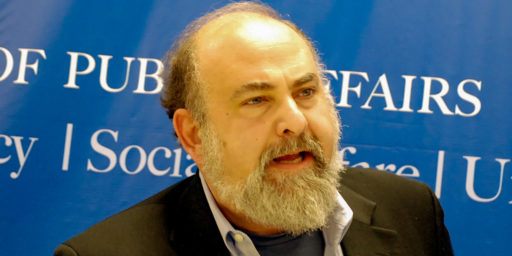Fighting Global Warming With Color
Jonah Goldberg has re-ignited an interesting meme: Replacing black roofs on buildings with white ones and adding chalk dust to asphalt to make our roads light gray rather than black. This, supposedly, will conserve energy, make urban areas cooler, and even help reduce global warming. Blogospheric luminaries from Kevin Drum to Megan McArdle to Matt Yglesias are on board.
I haven’t the engineering background to assess the feasibility of this but it sounds plausible. Mark Kleiman is likely right, though, that the proposal will go nowhere because it isn’t sexy enough to sell politically and there isn’t enough money to be made to generate major lobbying efforts.






Don’t ignore unintended consequences before going too far with this. Gray reduces contrast so I predict a lot more automobile accidents if this plan goes through. In northern climes will air conditioning bills go down in the summer more than heating bills go up in the winter if roofs aren’t covered with asphalt? Why not just start with whitewashing dilapidated housing in our cities and measure the local effects first, or hire Christo to cover, say, Nevada or the Sudan in some pale cloth? On the other hand, what a jobs program to rip up all the roads and rip off all the roofs for replace them.
On the other hand, what a jobs program to rip up all the roads and rip off all the roofs for replace them.
Presumably, we’d just do this as we replace or rebuild roads and roofs.
Good point on contrast/accidents, though.
Where pray tell is all the energy that no longer being absorbed by the black roofs and roads going? My physics education would lead me to believe if it isn’t being absorbed by the evil black bodies, it is being reflected back into the atmosphere. So let’s see that would lead to hotter days and cooler nights whereas now the black bodies absorb heat during peak power periods and release it during low power periods.
They aren’t called the Laws of Thermodynamics for nothing.
‘First law of thermodynamics
“In any process, the total energy of the universe remains constant.”‘
Now let’s speculate, more heat being reflected back into the atmosphere during the day, leads to rising warm air, which would inhibit cloud development during the day, which would let more solar energy reach the surface. On the otherhand, less radiant heat at night would lead to cooler air descending, more nighttime clouds, which would keep more warmth in the lower atmosphere. Am I right?
JKB,
You’ve got it about halfway right.
Yes, and also through the atmosphere back out into space, reducing the net amount of energy captured by the earth. The key here would be to reflect back radiation in the higher frequencies so that they pass through the atmosphere and are not absorbed by it. Also, there is still no scientific consensus about whether more energy in the atmosphere will increase or decrease cloud cover.
And it would reflect out into space if it weren’t for that pesky humidity. Or maybe I’m just biased by the 95% humidity of the South, and tropics.
Of course, I suspect those promoting this idea are biased by their local experience. On a global scale there is more non-black surfaces than buildings and roads. Unless, you live is a city that is. The only way to affect the so called global warming is to block the sun. Or stop all the hot air coming out of the global warming promoters.
How about we just work out how to have a hemispherical cloud cover track the daylight. That way the irritating life giving solar radiation can’t reach the surface during the day and all the stored energy can all radiate out into space at night. Then we can have lots of cold weather but miserable lives.
Of course keep in mind, that earth will adapt regardless of what happens but we just might have the ability to alter the very small finite climate conditions in which we can live comfortably. I remember back in 1997 when many were calling for stopping the evil El Nino. I say go ahead, do it, just be prepared to die. It’s not nice to mess with Mother Nature.
Hmmm, CO2, CH4, H20 vapor. Those can hold heat in. Dihydrogen Oxide in concentrations sufficient to precipitate out of the atmosphere in the form of clouds is really good at that.
White buildings are best in climates with clear daytime skies and a strong sun.
Even if this stuff actually worked well, you have to remember it’d only work on the percentage of the Earth’s surface covered by buildings and roads. Crackpot scheme, in other words, to avoid carbon tax.
How hard would it be to mix chalk with asphalt? Not much. Plus, you don’t need the Department of Transportation or a Congressional earmark to make this happen. If Wisconsin is similar to the rest of the nation roadbuilders are a powerful interest group. They’d be more than willing to pad their costs and add chalk if it meant more roads paves and more revenue in their pockets.
The energy is reflected back into space. Very little is absorbed by the atmosphere, because the atmosphere is transparent to the wavelengths that reach the surface. (Practicallyl by definition.)
During the night, the white surface is a poor radiator of heat compared with the dark surface. The dark surface cools faster. Hence the actual effect is cooler days and warmer nights.
So you pretty much got it backwards.
Whether this is cost-effective is another matter. A lot of houses where I live, in the Southwest, already are roofed with white-pigmented asphalt, because it certainly has a beneficial local effect. Lighten up the roads, and maybe you could reduce the urban heat island effect. I doubt it would have much effect on overall climate.
The thought of driving on gleaming white roadways makes me cringe.
Only they’re not talking about reflecting heat (low energy), they’re talking about reflecting light (high energy). The reason the chemicals you mentioned are green house gases is because they allow high energy solar energy to pass through to the earth’s surface, then trap the low energy heat radiated by the surface. Basically making the atmosphere a one-way path for solar energy.
I don’t know if this is a scheme to avoid carbon tax, but it certainly is a crackpot scheme for the exact reason you mentioned. There is simply not enough surface we can turn white to make a difference.
This one has been tested and researched to death by the Berkeley National Energy Lab.
1. the benefit is not about increasing the Earth’s reflectivity or albedo. The total roof area relative to the surface area of the planet is too small. This is likely even true even if we made all the roadways lighter coloured (after all, land is only 27% of the planet’s surface).
The benefit comes from *reducing air conditioning load*. As most electricity on a hot day comes from coal-fired electricity, the effect on greenhouse gas emissions is quite dramatic. (most US utilities have a summer peak)
A second order (but important) effect is the urban heat island effect. This can be as much as 10 degrees Fahrenheit on a hot day. By reducing *your* air conditioning load, you can reduce *your neighbour’s* air conditioning load (since he has to cool the hot air you spill out).
The countereffect is in winter you lose some heating value. However even in New York City it has been estimated the gain is 12:1 because:
– in winter the sun shines less often ((shorter days, cloudier)
– in winter the sun shines at a lower angle, so it hits less of the roof for less time
The estimate is the US could save up to 10% of electricity consumption, if it fully implemented all these proposals.
California in fact has passed laws requiring lighter coloured roofs.
give examples of the scale of energy efficiencies possible: since 1980, electricity consumption in California per capita has stayed static, whereas it has risen by 40% in the US as a whole.